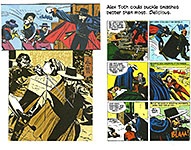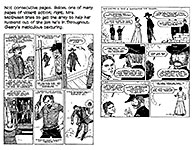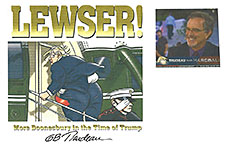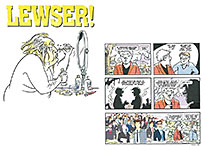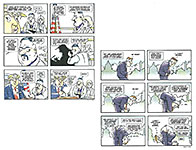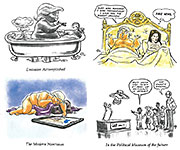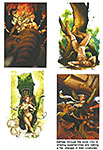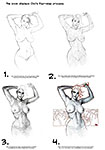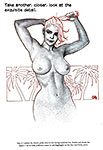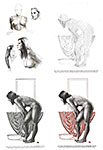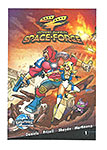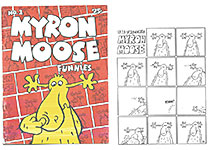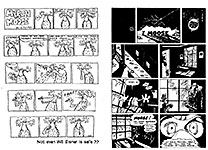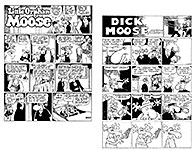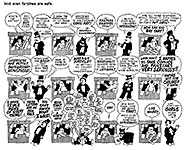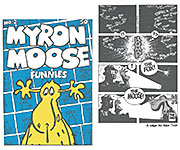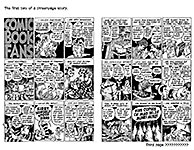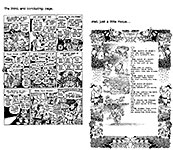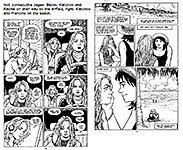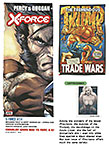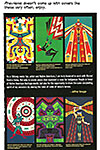 |
|||||||||||||||||||||||||||||||||||||||||||
Opus 408 (news thru September 30, 2020). The usual array of editoons and unusual comic strips, plus reviews of the year’s most wondrous comicbook, Hedra; Terry Moore’s Five Years: Stalemate; Myron Moose, Frank Cho’s extraordinary Ballpoint Beauties and Beetle’s 70th. Here’s what’s here, by department, in order (the longest entries are marked with an asterisk*)—: NOUS R US New York Comic Con Postponed, Metaverse On DC Comics Staff Laid Off DC Universe Finite Forthcoming Black Animated Series Hy Eisman Documentary A-borning The End of John Muir Apologies for Alleged Anti-Semitism Another Editoonist Laid Off Get Bugs Graphic Novels Priced Low Mark Trail Gets a New Look Google Doodle with Jackie Ormes Stars & Stripes Spared Trump’s Axe Further Adventures of the Wimpy Kid Davenport Cartoon Contest Winners
ODDS & ADDENDA Dark Horse Gets ComiXology Originals
FUNNYBOOK FAN FARE Reviews of First Issues Of—: Chu *Hedra Bad Mother Year Zero Quick Cuts—: Wonder Woman: Her Greatest Victories Green Hornet Dead Body Road Lost Soldiers Undone by Blood Artemis & The Assassin Decorum Adventureman
THE FROTH ESTATE The Case for Butts
*KEEF’S “WOKE” ON HULU
RANCID RAVES GALLERY BroomHilda and Russell Myers
TRUMPERIES The Antics and Idiocies of Our Bloviating Buffoon in Chief Does Putin Have “Something” on Trump? Leadership
EDITOONERY Editorial Cartoons from the Last Two Weeks
NEWSPAPER COMICS PAGE VIGIL Mutts Celebrates Popeye’s 90th Daring in 9 Chickweed Lane Sally Forth Sex *Realistic Rendering in Baldo *Celebrating Beetle’s 70 Years 9Eleven —and More
ACCRETION OF INTENTION DEPARTMENT Alex Toth’s Zorro Rick Geary’s Lincoln County War (Billy the Kid Stuff)
BOOK MARQUEE Short Reviews Of—: Lewser! More Doonesbury in the Time of Trump UnPresidented: Cartoons of Chaos The Art of Frank Cho Frank Cho’s Ballpoint Beauties Stormy Daniels in Four-color Fantasies Online Comic Book about Trumpet Pandemic Failures “Chaykin’s” Blackhawk
COLLECTOR’S CORNICHE Myron Moose Funnies
LONG FORM PAGINATED CARTOON STRIPS So-Called Graphic Novels Five Years: Stalemate (Terry Moore)
Previews Art
Windmills of Your Mind Lyrics
QUOTE OF THE MONTH If Not of A Lifetime “Goddamn it, you’ve got to be kind.”—Kurt Vonnegut
Our Motto: It takes all kinds. Live and let live. Wear glasses if you need ’em.
But it’s hard to live by this axiom in the Age of Tea Baggers, so we’ve added another motto: Seven days without comics makes one weak. (You can’t have too many mottos.)
And in the same spirit, here’s—: Chatter matters, so let’s keep talking about comics. AND—
“If we can imagine a better world, then we can make a better world.”
And our customary reminder: don’t forget to activate the “Bathroom Button” by clicking on the “print friendly version” so you can print off a copy of just this installment for reading later, at your leisure while enthroned. Without further adieu, then, here we go—:
NOUS R US Some of All the News That Gives Us Fits
IN-PERSON NEW YORK COMIC CON, KAPUT FOR 2020 But Metaverse Clambers Right In It’s been hovering around for weeks, and then, exactly two months before its scheduled date, ReedPop did what everyone expected it to: it canceled its in-person New York Comic Con, originally scheduled for October 8-11, and announced a virtual event for those dates. This would have been the 15th New York Comic Con at the Javits Center. According to Heidi MacDonald at publishersweekly.com, New York Comic Con is taking its mammoth real-world presence into a new virtual space, dubbed the Metaverse. During a year that has seen every major comics convention and book festival since March canceled, the biggest pop culture convention of the fall’s online iteration, the New York Comic Con Metaverse, will be held October 8–11 via YouTube. Show organizers hope that the lessons they have learned over the first six months of virtual cons will lead to a more vibrant and compelling fan event. ReedPop designed the Metaverse with the intent to present the elements of a comic con—the programming, publisher exhibitors, artist alley, and fan presence—in a more engaging way than the now-ubiquitous Zoom video chat platform allows for. NYCC comes along during a proliferation of virtual con events ... and digital fatigue is very real. Virtual cons, including ReedPop’s recent Metaverse event in August, which functioned as an online warm-up for NYCC, are becoming more complex and innovative in how they cut through online clutter to reach fans and readers. Making a virtual event stand out has become more competitive in just the past few months, says ReedPop v-p and event director Mike Armstrong. The company’s first Metaverse event, a trial run held in August, included both live and prerecorded panels, as well as exclusive merchandise and listings for exhibitors and artists. ReedPop has been “pivoting into what all of this stuff will look like digitally,” Armstrong says. “The Metaverse was our attempt to bring some content to fans, but also to figure this whole thing out a little bit. I don’t think anybody has perfected it.” NYCC Metaverse will have much of the traditional content of NYCC’s IRL editions ... with an emphasis on providing sneak peeks at trailers and covers, exclusive content, and author workshops, which are very popular with fans. Looking to avoid still more talking heads on a computer screen, showrunner Kristina Rogers is searching for ways to offer conversations on fresh topics by dynamic participants. “We’ve seen a lot of iterations, and we’re still trying to figure out what’s actually going break through the noise,” she says. Meanwhile, the comics industry is still dealing with the overall effects of a six-month pandemic. Milton Griepp, CEO of pop culture news and analysis website ICv2, acknowledges that retailers have been hurt by a lack of conventions but warns that “the long-term effect on the [overall] industry is probably more important,” noting, “All the deals that didn’t get done, all the chance meetings that didn’t happen, all the connections that didn’t happen—I think that’s really where we lose as a business.”
DC COMICS STAFF LAID OFF In Great Numbers By Heidi MacDonald at comicsbeat.com DC COMICS’ parent company, Warner Bros, reportedly laid off 600 people. At DC, the lay-offs were comparable: two people have separately told me it was "a bloodbath." Reports are that a large number of senior staffers were let go, including many senior editorial, marketing and administrative personnel. Editor in Chief Bob Harras is among those who are now out. It's also evident that those who had large titles and big salaries are also gone, but such is the way of business in the world. The end of DC Collectibles, if true, is also huge and telling. ... From everything I'm hearing, this is a huge and significant downsizing of DC's publishing operations that will have huge ripple effects across the entire Covid-scarred comics industry landscape. It's impossible to see this as anything but a huge sign of disinterest in the comics publishing business by AT&T, WarnerMedia and the Global Brands division. While other WB divisions also faced severe layoffs, losing such a huge swath of the executive leadership at DC is a lot more than just more layoffs. ... Among other things, there is also the horrible irony of the timing— in only two weeks Warners will hold DC Fandome, a huge 24 hour “mega, 24-hour, immersive virtual fan experience.” While a lot of DC freelancers were teased for the event, one can grimly picture the crew of surviving DC staffers trying to act happy for this event, while DC's film and media efforts are promoted...and the comics, the lifeblood of the universe, are left behind.
In Other DC News—: DC UNIVERSE INFINITE FORTHCOMING By Calvin Reid, publishersweekly.com In a move anticipated after the recent launch of HBO Max, WarnerMedia’s video on demand streaming service, DC Comics announced that DC Universe, a separate but similar service offering DC films, TV shows, comics, and an online community, will be transformed into a digital comics subscription service in January 2021. Beginning next year, DC Universe will be renamed DC Universe Infinite, and will offer subscription access to more than 24,000 digital comics from across the DC comics backlist at DCUniverseInfinite.com and on iOS and Android devices for $7.99 a month or $74.99 per year. The service will be available in the North American market in January and internationally beginning in the summer of 2021. It is comparable to Marvel’s Marvel Unlimited, digital comics subscription service launched in 2007 that offers subscription access to 27,000 digital comic books, at $9.99 per month, from across Marvel’s extensive backlist of superhero comics. The digital comics subscription service will offer comics, digital-first comics, and original graphic novels spanning more than 80 years of the DC comics backlist. New comics will be available via the DCUI six months after they appear in print in physical stores.
BLACK ANIMATED SERIES Animated shows with Black people and culture showcased are available through various tv-based operations, to wit—: “Doc McStuffins” features a pint-sized M.D. who fixes toys, some of which come alive. Stream it on Disney Now, Disney+, Sling tv and YouTube tv; buy it on Amazon, Google Play, and iTunes. “Static Shock” takes the teenaged Milestone Comics superhero Virgil Hawkins out of the comicbooks and into motion. Stream it on DC Universe. “Craig of the Creek” features young Craig and his playmates who use the world as their playground and his close, loving Black family. Stream it on CartoonNetwork.com, HBO Max, Sling tv and YouTube tv; buy it on Amazon, Google Play and Vudu. “The Proud Family” is a normal Black family living in the suburbs and the minor conflicts the teenaged Penny encounters at school and elsewhere. Stream it on Disney+ “The PJs” is Eddie Murphy-stop motion animated life in the inner city life, but despite Emmys for animation and voice acting, it cracked too many jokes about delinquent youth, crackheads and neighborhood violence to suit Spike Lee, who said it was “hateful toward Black people”; but it’s still around. Stream it on Pluto tv. Based upon Aaron McGruder’s satirical comic strip of the same name, “The Boondocks” is about a couple Black youths who move from a Black inner city to a White neighborhood where the film takes shots at stereotypes, tropes and prejudices. Stream it on HBO Max, Hulu Live and YouTube tv. “Black Dynamite” overstates blaxploitation genre with raucous action sequences, loud fashions and large Afros to create satire with as many off-color jokes and other outrageousness as it can. Steam it on AdultSwim.com, Hulu, Sling tv,YouTube tv; buy it on Amazon, Google Play, iTunes and Vudu. “Afro Samurai” is a vividly stylized take on the samurai genre with a hodge-podge of cultural referents—old school samurai, blaxploitation, shonen anime. Stream it on Hulu and Tubi; buy it on iTunes. “Little Bill” features moral stories in flash animation with characters whose skin is in every shade of black and brown. Buy it on Amazon, iTunes and Vudu. The idea of this article and most of its words are shamelessly appropriated from Maya Phillips’ New York Times story, which goes into much more detail than I’ve appropriated. Look for “From Proud Family to The Boondocks: 11 Black Animated”
HY EISMAN DOCUMENTARY IS LOOKING FOR FUNDING From Go Fund Me Description At 93, Hy Eisman is still the cartoonist for King Features’ Sunday Popeye. Until 2017 or so, he also produced The Katzenjammer Kids until that strip was retired. Now in his 70th year of freelancing, Eisman is a man who has made a lifelong commitment to the arts and succeeded in an industry that has undergone transformation time and again. He was born in 1927 and has been entertaining readers of the funnies since 1950. Eisman has been granted several of the cartoon industry’s most respected awards; and he is the 2019 recipient of the Milton Caniff Lifetime Achievement Award. Against all odds, he has overcome many hurdles as a comic artist, stemming from his years at an orphanage and extreme financial hardships from early childhood. If you ever met Eisman, you would sense no sign of his difficult past, and how he has battled upward into a career notorious for its many flaws and uncertainties. Eisman’s friends testify to his remaining a perfect gentleman to everyone he meets, as he shares his lifetime stories. A documentary about his life and work is brewing; details at https://www.gofundme.com/f/hy-eisman-a-life-in-comics-feature-documentary
THE END OF JOHN MUIR The Sierra Club has decided it’s time to take down monuments dedicated to the group’s founder and renowned conservationist, John Muir, citing his relationships with known white supremacists. Muir, who founded the club in 1892, helped spawn the environmental movement and is called “father of our national parks.” No longer. “Today,
Muir has become such an icon that it’s hard to remember that he was ever a
living human being, let alone a wide-eyed and adventurous young man—a Gilded
Age flower child. Even at the Yosemite Visitor Center, he’s depicted in a
life-size bronze statue as a wizened prophet with a Methuselah beard. In a
nearby museum, his battered tin cup and the traced outline of his foot are
displayed like religious relics. And his pithy inspirational quotes— ‘Climb the
mountains and get their good tidings,’ ‘Nature’s peace will flow into you as
sunshine into trees’—are everywhere. “But all this hero worship risks obscuring the real story of the man and his achievements.” It turns out that he associated with people who felt Whites to be better than Blacks or Native Americans—in today’s term, “white supremacists.” And Muir was not immune to the racism peddled by many in the early conservation movement, often under the fake scientism of “eugenics.” According to the Sierra Club’s executive director, Michael Brune, “Muir made derogatory comments about Black people and Indigenous peoples that drew on deeply harmful racist stereotypes, though his views evolved later in his life.” Muir once referred to African Americans as lazy “Sambos,” a racist pejorative that many Blacks consider to be even more offensive than the n-word. While recounting a legendary walk from the Midwest to the Gulf of Mexico, Muir described Native Americans he encountered as "dirty." Muir’s biographer says that while everything Muir did was not admirable, most of what he accomplished was. And he wasn’t a white supremacist. Moreover, as Brune pointed out, Muir’s views “evolved later in his life.” But none of that matters. Because Muir participated in the prejudices of his time, he will be erased from the Sierra Club, his statues taken down and other signs of his having lived and accomplished much of benefit to his fellow man—all of that will be removed so that the Sierra Club can be pure. Why did they put up a statue to Muir in the first place? It wasn’t to memorialize the whole man. It was to remember what he achieved for the conservation of nature in this country. So now, we’re going to set out on a journey to disremember all of that. Phooey. Tinkering with history is a lot different than perpetuating evil stereotypes today.
We can say the same about Christopher Columbus. It’s the discovery of the Western Hemisphere and the courage it took to make the voyage of discovery (when no one else had attempted the cross-Atlantic trip) that is commemorated with statues of Columbus—not he and his crew’s having brought Old World diseases with them to infect Native Americans. Many of those bent on defacing or tearing down statues of Columbus do so because they believe his arrival signaled the beginning of a genocide against Native Americans, where he enslaved, brutalized, and killed thousands of Native people—according to both his own diaries and letters and those of people with whom he traveled. But these arguments are immaterial to the monuments. We need to put on our Big Boy pants and face the world as it is instead of trying to re-cast the past as if it were children’s modeling clay.
PAPERS APOLOGIZE FOR ALLEGED ANTI-SEMITIC EDITOON The Tallahassee Democrat ran a syndicated editorial cartoon that showed former New York City Mayor Michael Bloomberg in a way that some said drew on stereotypes of Jewish people. “It was a mistake and we apologize,” editor William Hatfield said. “Our editorial page editor, who is Jewish, selected the cartoon and it was reviewed by another editor, but that clearly wasn’t enough.” Florida Today made the same mistake with the same cartoon by Joey Weatherford. The cartoon depicted “Bloomberg, who is Jewish, rubbing his hands together over bags of money,” wrote Today’s Isadora Rangle. “It without doubt drew on anti-Semitic images and stereotypes dating back centuries. These were historically meant to stir hatred and intolerance. It had no place on the pages of Florida Today, and we are deeply sorry.”
I looked at the cartoon before reading the articles and I saw nothing wrong with it. Neither did the Jewish editor at the Tallahassee Democrat. Better be safe than sorry, though. Better to err this way than the other. At least if we fix such matters now, when they’re happening, we’ll save future generations the trouble of re-writing history.
ANOTHER EDITOONIST LAID OFF The Ranks Continue to Thin Editorial cartoonist Jeff Koterba was laid off by the Omaha World-Herald this month. Koterba announced it himself via his Twitter feed: “It is with deep and profound sadness that I must tell you that today, after over 31 years of drawing daily cartoons for my beloved hometown newspaper, the Omaha-World-Herald, my job was eliminated due to cost-cutting measures.” He went on to express his gratitude to readers and supporters: “I am grateful to the many wonderful colleagues with whom I have worked these many years—fellow hardworking journalists who have taught me a great deal. But more than anything, I am forever indebted to you, my dear friends and readers, for your support and kindness during my career. “I’m honestly still in shock and will certainly share more about future plans down the road. But for now, I’m just grateful for the many wonderful humans in my life. “I am blessed.” According to St. Wikipedia, Koterba has been cartooning for his hometown since he was a teenager. He drew editoons for his high school newspaper and for his college newspaper at the University of Nebraska at Omaha. While in college, he also drew cartoons for the suburban Omaha newspaper, the Bellevue Leader. After college he drew sports cartoons on a part-time basis for the Kansas City Star from 1986 to 1989, and his work also regularly appeared in the Los Angeles Times. He was hired by the Omaha World-Herald in 1989, filling a 9-year void at that position. While at the World Herald, Koterba has occasionally written editorials and feature stories. Koterba describes himself as “passionate centrist.” He will continue editooning with Cagle Cartoons. His departure from a full-time staff editoonist position, decreases the ranks of the nation’s editorial cartoonists. It could number as few as 30 or as many as 48, depending upon whose count you use. My own count, which starts with a list promulgated in May 2008, is 39.
GET BUGS
GRAPHIC NOVELS PRICED LOW I subscribe to a bargain book catalog, and one of the current issues lists books of fiction, which includes 12 pages of “graphic novels,” mostly compilations of comicbook titles—Superman, Batman, X-Men, etc. There are, however, a few off-beat titles among the lot. To indicate the savings you might achieve: many books initially priced at $29 are reduced to $6. You can subscribe to the catalog at Edward R. Hamilton Bookseller, P.O. Box 15, Falls Village, CT 06031-0015; but you can also order from the website, which is where all these “Graphic Novels and Comics” can doubtless be found: www. HamiltonBook. com.
MARK TRAIL GETS A NEW LOOK The environmental champion comic strip Mark Trail, which began as long ago as 1946, will be produced by Jules Rivera, starting October 12, announced Heidi MacDonald at comicsbeat.com. If you have never heard of Mark Trail, observed George Gene Gustines at nytimes.com, no worries — neither had Rivera, known for her slice-of-life webcomic Love, Joolz. “It’s not something that would have made its way to my purview,” she said in a recent telephone interview. “I didn’t seek out nature-dude comic strips.” But she told Gustines that she discovered a lot to love about Mark Trail while doing her research on the strip. “Mark goes on the wackiest adventures; there were many, many exploding boats,” she said. In one, she said, a walrus gave birth in an automobile. In another, Mark was trapped in a cave for 48 hours — which played out over many weeks of the strip and caused some consternation among fans. “The writer actually had him there for six months,” she said. “That’s depth!” (“That’s a cave joke,” she added.)
Rivera does not see her take on Mark Trail as a reboot. Instead, she describes it as a “blowup,” a bigger focus on the characters and themes of the strip but with a modern sensibility, which let her put her degree in electrical engineering and a background in STEM to use. She’s also updating Mark’s look.Among the other enhancements: His wife, Cherry, and their son, Rusty, will receive more prominent roles.
GOOGLE DOODLE FOR SEPTEMBER 1 CELEBRATES PIONEERING ARTIST JACKIE ORMES —The First Professional Black Woman Cartoonist in the U.S. THE OCCASION, said Sarah Cascone at artnet.com, is the 75th anniversary of Jackie Ormes’ longest-running cartoon, Patty-Jo ‘n’ Ginger, first published on September 1, 1945. The single-panel cartoon, which featured the precocious insight of Ginger’s young sister Patty-Jo, ran for 11 years and inspired a toy doll from Terri Lee that eschewed common racial stereotypes. Patty-Joe gets all the good lines in the comic, including a few scathing comments on the evil of racism. Ormes also did a Sunday comic strip, Torchy Brown in Heartbeats. To
design its homepage tribute to Ormes, Google tapped Philadelphia-based artist
Liz Montague (who we last wrote about when she started getting published in The
New Yorker, the first Black woman cartoonist to make it into the magazine;
see Harv’s Hindsight for July 2020). “I drew a lot of inspiration from Jackie’s illustration style, such as the lines she uses as well as her compositions and layouts,” Montague told Google. “Jackie is a huge inspiration for me. … The illustrations are immaculate, the humor is witty, the social criticism is bitingly accurate—her work is just the total package. She is why I create cartoons as social justice and why I feel valid doing it. Jackie is a genius and paved the way for so many of us as a pioneer in the cartoon and illustration world.” ... “Her work was unique and wholly unprecedented. Not only were her lead characters female, they were strong, elegant, intelligent, urbane, opinionated, and witty and often leading extremely glamorous and cultured lives,” Josphine Liptrott wrote of Ormes in a biography for the Heroine Collective. “They challenged the derogatory caricatures of Black people, and especially Black women, which usually appeared in comics at that time.” For much more on Ormes, see Opus 219
STARS & STRIPES SPARED THE TRUMPET’S AXE Contrary to the rumor the Trump administration started, the funding of the Stars & Stripes, the Army newspaper since the Civil War, will not be cut. As soon as an outcry of objection arose to the report of defunding the paper, Trump jumped in and announced that “the United States of America will NOT be cutting funding to Stars & Stripes under my watch,” he tweeted (employing a military expression, “my watch,” that he, as a likely draft dodger, could scarcely have any personal experience with). Said he: “It will continue to be a wonderful source of information to our Great Military!”
But press advocates weren’t thinking of Willie and Joe, Mauldin’s rumpled and whiskery characters, when they decried the threat to the paper, arguing instead that it was the latest in a series of decisions by the Trump administration to undermine independent reporting. Trump was quick to deny he had anything to do with the defunding project, describing the unnamed sources that started the “rumor” as "low lifes" and "liars."
THE FURTHER ADVENTURES OF THE WIMPY KID Book Touring in the Pandemic and Fixing Your Car, Too SHORTLY AFTER THE ROARING SUCCESS of the first few Wimpy Kid books, author Jeff Kinney made a presentation at the Reubens Weekend convention of the National Cartoonists Society, and during the course of his remarks, he said the most recent Wimpy Kid was going to be his last. That was eight or ten Wimpy Kid books ago. He can’t stop writing them. The fifteenth will be published in October; and Kinney has started on a new series about the Wimpy Kid protagonist Greg Heffley’s friend Rowley. If Jeff Kinney has faith in one thing, six months into the new coronavirus outbreak, said Alex Green at publishersweekly.com, “it is the importance of even the smallest moments of human connection. Driven by that sentiment, the bestselling author personally handed off signed copies of his new book, Rowley Jefferson’s Awesome Friendly Adventure (Abrams/Amulet, now at Number One on the children’s middle grade hardcover list) in what very well may be the first multi-stop, in-person, socially distanced book tour by a children’s author since the virus began to spread.” In August, Kinney jumped in an “Awesome Friendly Adventure” van filled with books and drove to eight independent book stores in the northeast corridor. Equipped with a Wimpy Kid mask and an extra-long grabber for passing copies to customers, he drove an orange cargo van (“a futuristic ice-cream truck”) from Pennsylvania to Vermont, braving storms and downed trees along the way. But “it wasn’t all scenic views and adoring crowds,” reported Elisabeth Egan at nytimes.com. “Kinney’s exhaust pipe hit the ground during a flash flood in Philadelphia, so he consulted YouTube, got on his back in a hotel parking lot, slid underneath the van and fixed it.” “I’ll go on record,” he laughs. “I’m the least handy guy. I have a pianist’s hands.” In addition to visiting bookstores, Egan said, Kinney made house calls to bereaved families and children of frontline workers. He says, “That was really the most rewarding part. It was fun to pull up in a neighborhood in this really brightly decorated van, and sometimes neighborhood kids would run alongside it. Sometimes kids didn’t know this was happening — their parents had kept it as a surprise — so I’d tell them, ‘This is what happens if you read a book. The author will come to your house.’” Luckily for his devoted fans, Kinney is hard at work on his next book, which comes out this fall. In the meantime, he has advice for kids on the threshold of a new school year: “You have to go into this season with a sense of humor because we’re stuck in this situation that has an ending; it’s just unclear when that ending will be. 2021’s going to be a lot better than 2020, that’s for sure. Enjoy your time with your family. Enjoy this weird situation if you can. Once the world opens up again, it’s going to be an awful lot of fun.”
DAVENPORT CARTOON CONTEST WINNERS ANNOUNCED Press Release Homer Davenport had a relatively short (1889-1912) career as a political cartoonist, but once he began working for Hearst’s San Francisco Examiner (in 1894) and especially, later (in 1895), the New York Journal, he became more adept at his craft—and famous. But Davenport never forgot his humble Oregon roots in hometown of Silverton. And in his memory, Silverton holds its main summer festival and conducts a Cartoon Contest that invests the occasion with the wit and images of cartoons. This year, the Festival had a total of 33 entries, representing cartoonists from around the country. As in past years, the competition is for “political” or “editorial” cartoons on any topic as long as they are not libelous, slanderous, racist, sexist or salacious. The winning entries are awarded monetary prizes of $750, $500, $300 and $200. There are an additional five non-cash “People’s Choice” awards determined by attendees of the Festival. Due to the current Covid-19 Pandemic, all the entries were displayed on the “Homer Page” as well as the Homer Days Facebook page, where the general public was invited to vote online for their top five personal favorites. The five highest of these are awarded the “People’s Choice” certificates. There were just under 1,000 votes. The winning entries:
Judged Winners: Grand Prize ($750): Jack Wiens - Ashland, OR 1st Prize ($500): Steve Greenberg - Torrence, CA 2nd Prize ($300): Phil Fehrenbacher - Salem, OR 3rd Prize ($200): Bill Stanford - Williamsport, PA
People’s Choice Winners: First: Jeremy Kranz - Olympia, WA Second: Dan McConnell - Cashmere, WA Third: Keith Amano - Silverton, OR Fourth: Kristin Aalbue - Silverton, OR Fifth: Dennis Townsend - Tacoma, WA
All entries from the 2020 competittion can be viewed on the Web: http://HomerDavenport. com/ tooncon/
ODDS & ADDENDA ComiXology Originals has been turning out a fine slate of creator-owned titles for a few years now, and while some were available in POD print editions, they haven’t been released to the comics market in print. But that is changing, Heidi MacDonald reports at comicsbeat.com: “it’s just been announced that Dark Horse will be the print partner for ComiXology Originals graphic novels and collections starting in Spring 2021. The line will launch with paperback collections of the Eisner Award winner Afterlift plus Breaklands, Youth, and The Black Ghost.”
Fascinating Footnit. Much of the news retailed in the foregoing segment is culled from articles indexed at https://www.facebook.com/comicsresearchbibliography/, and eventually compiled into the Comics Research Bibliography, by Michael Rhode, who covers comic books, comic strips, animation, caricature, cartoons, bandes dessinees and related topics. It also provides links to numerous other sites that delve deeply into cartooning topics. For even more comics news, consult these three other sites: Mark Evanier’s povonline.com, Alan Gardner’s DailyCartoonist.com (now operated without Gardner by AndrewsMcMeel, D.D. Degg, editor); and Michael Cavna at voices.washingtonpost.com./comic-riffs . For delving into the history of our beloved medium, you can’t go wrong by visiting Allan Holtz’s strippersguide.blogspot.com, where Allan regularly posts rare findings from his forays into the vast reaches of newspaper microfilm files hither and yon.
FURTHER ADO When you’re as old as I am, son, you get to do pretty much anything you want to. But at my age, there’s not much you can do.—RCH
FUNNYBOOK FAN FARE Four-color Frolics An admirable first issue must, above all else, contain such matter as will compel a reader to buy the second issue. At the same time, while provoking curiosity through mysteriousness, a good first issue must avoid being so mysterious as to be cryptic or incomprehensible. And, thirdly, it should introduce the title’s principals, preferably in a way that makes us care about them. Fourth, a first issue should include a complete “episode”—that is, something should happen, a crisis of some kind, which is resolved by the end of the issue, without, at the same time, detracting from the cliffhanger aspect of the effort that will compel us to buy the next issue. A completed episode displays decisive action or attitude, telling us that the book’s creators can manage their medium.
THE COMICBOOK Chu is drawn like no other comicbook these days. Dan Boultwood’s clean- and crisp-lined characters are severely stylized, so much so that we see design instead of bigfoot, which is what we would otherwise claim for it. The result is a prevailing attitude of humor even though John Layman’s story is a straight-forward cops and robbers tale. We meet the robbers first, a band of half-a-dozen thieves, who are planning to rob the ill-gotten gains of another band of robbers led by Don Digiorno Bucatini. Everything goes according to plan until, halfway through the caper, Bucatini’s men return unexpectedly from making their rounds collecting protection money. Shooting and killing ensues. And then the police arrive to investigate, whereupon we meet the book’s title character, Tony Chu, who, we soon learn, is the brother of one of the band of thieves, Saffron Chu.
Having set up the story’s central conflict, this first issue ends—with us panting for more. Writer Layman says that Chu is his “Better Call Saul,” but Layman’s work is a good deal simpler than his model. Still, it includes enough completed episodes to display his skill at weaving a tale and depicting the personalities of his principals—although who those are is not immediately clear. The cover stars Saffron Chu, and we don’t meet her brother until well past the book’s halfway point. By the end of the issue, however, we know who Layman’s heroes are. Saffron exercises her leadership and analytical skills in extracting most of her gang from the midst of their snafu; and Tony shows off his cibopathic character. He can take a bite of an apple and tell what tree it came from, what pesticides were used on the crop, and when it was harvested. Just the talent a cop needs. I’ll be back—if for no other reason than to watch Boultwood at work again.
HEDRA IS WITHOUT DOUBT the most extraordinary comicbook of the season. It is a wholly visual experience with pages of 35 small, equal-size square panels in a neat, inflexible grid. It hits you in the face. This is a book about form, no story. But it uses form to tell a story. Without words. A wordless story, told entirely by visuals. Jesse Lonergan wrote and drew the book. His goal was to push the visuals as much as possible says Susana Polo at polygon.com. “All of the pages are based on a grid of square panels,” Lonergan told her. “I always began with that grid and whatever scene I had in mind. I would start with a more traditional sequence of panels and transitions, and then I would begin to try to break them down, take them apart, and put them back together in new ways. In many ways, it was something of a game I would play to see how far I could push the art and still have it make sense.” The story is simple, a nearly rote exercise of sf. The earth is ravaged by nuclear war. An astronaut, in this case a woman, is selected by lot to go on an interplanetary expedition to find some other suitable home for mankind. She lands on other planets and explores; picks up sample plantlife, rocks, minerals, etc. She encounters aliens and fights them and flees. She is befriended by a man in a metal suit (or maybe a machine man), who converts one of her arms to a metal mechanical. When she returns to the decimated Earth, she plunges her mechanical hand into the debris as hundreds of pentagons burst forth. In the next 2-3 pages, they revitalize Earth, and a butterfly floats by, symbolizing rebirth. She once again arises into space, where the round shape that embraces her on such expeditions assumes a pentagon shape as she rises, and we see “her” (“it”) from a far distance at the last page. Where is she going? Dunno. Meanwhile, back at the alien planet, one of the aliens gets into the woman’s abandoned spacecraft and takes off in it. On the back cover, we see it blasting off from the planet into space—a single image crossing parts of the 25-panel grid. It virtually duplicates the cover image, suggesting that the tale is beginning again. Hence, this is a story of perpetual renewal. The name of the book is almost no help in deciphering its meaning. “Hedra” is from ancient Greek: it means “face of a geometrical solid.” Just like the grid pattern? The grid pattern that pervades the book, page after page of it, is a visual carrying the story, and without that visual, the story is bland. With the visual, the story achieves the discipline of art. The form of the story is fraught with the element of simultaneity. Sometimes “a narrative picture” (of the woman or, later, of the mechanical man) is spread across several panels and faces other panels that are empty of story—vistas of the surroundings that give us the image of context for the story. Solid black squares. Geometry. I wonder how to “read” the pages. Follow traditional reading method? Read left-to-right, top tier down the page through successive tiers to the bottom tier, left-to-right all the way? But on many pages, there is no “narrative succession” from one panel to the next as in the usual comics format; reading this left-to-right is meaningless. Instead, you see the whole page; you “read” it more-or-less all at once. And upon turning a page, opening to the next page, you cannot ignore the “whole page” that confronts you—a grid of panels, some solid black; others, containing fragments of the story’s narrative “picture.” Then—what? You “see/read” fragments of the narrative picture while also seeing it whole and in the context of the rest of the page’s image. But all of this scarcely describes either the pages or the “reading” experience. For that, you must confront the pages to see how they work. And I’ve posted a selection of pages nearby and annotated them. Hope that helps. Those pages impressed me.
BAD MOTHER No.1 is another expertly done book albeit in another direction. Mike Deodato, Jr.’s drawings are uncompromisingly realistic: his line is steady without much variation, and he achieves his visual effects with feathering and shadowing. Written by Christa Faust, who wanted to show the everyday heroism of an ordinary middle-aged woman with a husband and two teenage children, a boy and a girl. “April Walters,” Faust says, “is a complex, flawed and realistic woman with grit and practical problem-solving skills and a profound reservoir of inner strength. A woman who takes care of everything herself, who does the stressful, plate-spinning full-time job of managing a home and a family on top of the thankless, invisible emotional labor she provides for the people she loves. She doesn’t know kung fu and has never fired a gun, but she is smart and relentless and will stop at nothing to save her daughter.” Faust, she is careful to tell us, is “proudly child-free at 50.” “No super powers,” Deodato chimes in. “Not a retired cop. No martial arts background. Just a mom. A soccer mom, a bit overweight. ...” We meet April at a clothing store where she’s trying on a pair of jeans but can’t fit into them. The clerk offers to find her a size twelve, but April walks away. It’s a complete episode done almost entirely in pictures, and we leave it without any doubt about what April has experienced and is consequently feeling. Next we see April at the supermarket for the next completed episode. In the midst of her shopping, the store is invaded by a couple of hoodlums who want to rob the cash register. But one of the customers, while dutifully crouched on the floor, calls the cops with his iphone, and when the cop cars pull up, one of the robbers runs off; the other takes a woman customer hostage, holding gun to her temple. But one of the cops, after telling the robber that “we can work this out,” pulls a gun and blows the guy’s head off. We last see April with blood splattered on her face. Deodato again tells the tale mostly with pictures, shifting from close-ups to distance shots, and the story moves purposefully from one aspect of the situation to the next. When she gets home, April phones her husband (off on a business trip) to tell him a little of what happened, but she’s shaken enough to want to spend the evening with her son. He, however, has plans to meet with a friend, so April is alone. When her teenage daughter, Taylor Jane, comes home, she has a black eye, and April wants to comfort her, but the daughter locks herself in her room. April then goes to find Taylor’s boyfriend, who presumably roughed her up, to give him a piece of her mind. The home is unlocked, and when April goes in, she discovers two dead bodies, teenagers—perhaps one is Taylor’s boyfriend; the other may be one of the robbers, the one who escaped. When April gets home, Taylor is missing. April goes to the police to report a missing person, but gets no cooperation: people aren’t missing until they’re missing for 48 hours. But when April tells the cops about the two dead guys, they go to investigate, taking April along. But
there are no dead bodies. The messy livingroom has been straightened up. No
blood. The cops think April’s suffering from a delayed mental shock after the
robbery incident at the grocery store. But we don’t see any evidence of
that—and we’ve seen the bodies! On the last two pages, we hear and then see a woman on the phone, promising to recoup her loses. Then we see Taylor, tied and gagged in the basement. Faust and Deodato have achieved a perfect setup for the 5-issue run of this title. We learn of April’s caring motherhood and wifehood despite her inability to fit into a new pair of jeans. We see her determinedly going to confront her daughter’s boyfriend for his behavior. Every step of the way, we learn more about April and her resolve. More next time, undoubtedly.
NEXT, WE TURN OUR ATTENTION to a story by Benjamin Percy. “Year Zero,” Percy tells us, “is a macro—a global account of a world in ruin.” He points to evidences of a modern horror “story”—“Australia is burning, and Venice is drowning. Yet another mass shooting bloodies the headlines. ... North Korea is readying another missile test. Hong Kong is rioting ... [and] the corona pandemic is just getting started.” In the midst of these horrors, Percy sets out to show the world through the lenses of several separate (for now) situations. “Here is a scientist at a polar research station. Here is a street urchin in Mexico City. Here is a Yakuza hitman in Tokyo. Here is a military translator with American soldiers in Kabul. Here is a prepper in suburban America. “I often approach a project with a stylistic goal,” Percy goes on. “In this case, I wanted the form to serve the function. The world is shattered, so the design should be as well.” As readers, we’ll fit the shards of the separate stories into a mosaic “that will ultimately give us a fresh understanding of what it means to be human in a post-human world.” Each of Percy’s separate episodes is complete in a different sense than I’ve been citing that criteria. Each introduces a character persuasively; and each character manages to complete some action. But Percy’s point, in this, the title’s first of five issues, is to create our sense of five different lives being lived separately. Percy’s objective is ambitious, and his artist is up to the task. Ramon Rosanas makes clean pictures —no feathering and very little of deep shadowing. Chiseled imagery takes us persuasively into each of the story’s five locales.
I
am amused by the cover, which depicts a van parked at the lake beneath the
three Colorado mountains known as the Maroon Bells, the most photographed vista
in the state. As a youth growing up in Colorado, I made several visits to
Maroon
BOTH OF THE COMICBOOKS we’ve just looked into are published under the Upshot imprint of the Artists Writers & Artisans (AWA) publisher. Both books are stylish undertakings visually and ambitious (can we say “mature”—“adult”) in their stories. An encouraging sign.
Rounding
Up—: Herewith, a few fleeting glimpses of funnybooks that have, for one reason or
another, caught my eye as I In several stories, she pledges undying love to Steve Trevor, the man in her life from the very beginning, and the two exchange passionate kisses. And then in another story she throws herself at Superman/Clark Kent. So—who is the love of her life? ◆ Dynamite has launched a try at Green
Hornet, an antique radio character who seems intriguing—crusading
◆ Elsewhere—imagine my surprise when, after witnessing Bree Hale emerge triumphant in the first issue of Dead Body Road (reviewed last time), I picked up Nos.2 and 3 and couldn’t find her anywhere. Instead, two or three really tough guys glowered at each other, clenched fists at one another, and pointed guns. What? So where was Bree and her fugitive brother Hunter? Well, they were in another No.2 of Dead Body Road. Yes,
there seem to be two No.2s. I’ve posted the covers of both second issues, and
you can see at a glance that they appear to be the same comicbook title. But look again: one of them has a subtitle “Bad Blood” in white type at the lower left. Aha! So Dead Body Road is a title telling two different stories. Right. And I just wasn’t observant enough to discern the presence of a subtitle. And the publisher, Image, played into my carelessness by publishing two No.2s, repeating in each one the same cover design. For shame, Image. And by the way—why so much use of the word “fuck”? It’s on virtually every page. Do we need realism that much? And what’s so real about “fuck”? Is that how reality is indicated? Use lots of “fucks”? A few “fucks” are fine; but not on every page, kimo sabe. ◆ Lost Soldiers No.1 is another boring treatment of war in which it is proven, again, that war is dehumanizing and pitiless. It is written by Ales Kot, who aspires to be a poet, and so he writes about the ugliness of war and cloaks his words in obscure metaphors that wander: “The bodies of men, those become exposed in the busy streets, across the early morning bridges, an architecture of pain, more borders to put fear into other men.” He’s chosen the wrong medium: comicbooks are essentially visual, and poetry is essentially verbal. ◆ And Undone by Blood No.5 is a pointless exercise in brutality and cruelty. I don’t need comicbooks like either of the latter two. ◆ Another loser is Artemis & The Assassin, which is up to No.3 and we still don’t know who Artemis is. The only two named characters are Maya, a time-traveling assassin, and Virginia Hall, a pegleg gun slinger in World War II’s resistance France. For two issues now, these two characters have been fighting: Maya keeps saying her job is to kill Ginny, and Ginny keeps defending herself. But we haven’t, yet, progressed beyond that situation. In short, this title is almost a textbook example of how mysteriousness destroys a book: there’s nothing but mysteriousness here. A certain amount of that is attractive; too much—as here—is just baffling without purpose. ◆ Decorum is up to No.4 now, and in No.3, the book gains a little story sense. Many pages are still just bizarre designs, but long segments of conversation between characters clarify certain previously just vague notions. Two women, one older and experienced, Imogen Smith-Morley; the other, Neha Nori Sood, younger. The older woman is taking the younger to enroll in a school for assassins. And that’s it for No.3.
The characters we became familiar with in No.3 are nowhere to be found in No.4, which begins with preparations for an invasion—which then happens later in the book. None of the people are recognizably of the homo sapiens sort; they’re some other manifestation. And some of them are concerned about a dwindling supply of mothers because they await the birth of the Messiah. Elsewhere, one civilization abandons “the egg,” which cracks and delivers a premature creature that’s mostly skeleton because it wasn’t able to grow flesh on short notice. I await No.5 in the hope that it will somehow tie all these strands together in a meaningful tale. ◆ With the arrival of Adventureman No.2, the second issue that all Terry and Rachel Dodson fans have been waiting for with bated breath, we now know that there is a second issue. I wasn’t sure there would be. In fact, there is also a third issue, open on my desk awaiting my perusal. But No.2 is important because as we read through it, we realize that Adventurean is a figment of the imagination of either l0-year-old Tommy or his hard-of-hearing mother, Claire. And that’s enough for this short visit—that and a couple more pages of Dodson art.
Ah—wait! I couldn’t wait: I read No.3. And it doesn’t help at all. Claire’s family has taken her to a hospital because they think something’s wrong with her. But she doesn’t agree: in fact, she is better than she’s ever been. In the course of the book, she saves the life of a boy by performing a field transfusion using (apparently) her own blood, which is of the universal sort. The doctors want to examine her, and when they do, they find she’s grown 15 inches since her last checkup. During Claire’s fantasizing, she assumes an Adventureman personna. I think. Not altogether sure. That evening at home, watching a tv movie, she fantasizes an attack by the Beast God of the Ultravoid, who is pictured in the second of our visual aids above. And she jumps on a motorbike and races off to do battle with the giant beastie. Beautiful artwork, still. And in Claire, we seem to have a woman whose fantasizing is slowly turning into something real. Will her two worlds somehow meet? They already have. The best way to approach this title is to think of it as a wild fevered celebration of adventure comics with all their dash-about action and implausible fight scenes. But it’s not a parody: it’s a cathedral in which everybody’s a superhero except the villains, and all the heroes are handsome and heroines beautiful. Like Dodson characters.
QUOTES & MOTS Sex expert Dr. Ruth was trained as a sniper by the Israeli military.
THE FROTH ESTATE The Alleged “News” Institution
The other thing about this photo is that it disproves a notion of mine. I have often been critical of comicbook cartoonists for drawing superheroines in the pose on display here. I’ve maintained that it is an anatomical impossibility to depict both bosom and butt in the same pose—that is, precisely this pose. Obviously, I’ve been wrong all these years. Happily, life goes on.
KEEF’S “WOKE” ON HULU Started This Month, September “The show is an extension of my sensibilities and my comics,” said Keith Knight, a Harvey Award-winning cartoonist known for three cartoon features, The K Chronicles, (th)ink and the syndicated comic strip The Knight Life, whose life and work is the inspiration for the comedy series. “I love addressing complex issues with metaphor and with humor, trying to distill it down in simple ways so people can understand it in a way that they may not have understood it before,” he told Tracy Brown at latimes.com (from which report, we’ve lifted everything that follows). “With the rise of the internet and the loss of newspaper ad revenue, I was getting dropped from papers because they just didn’t have the money and space anymore,” he said. After making some industry contacts (including “NCIS: Los Angeles”’ Eric Christian Olsen, whose father advocated for the show), he eventually connected with Marshall Todd, with whom he created “Woke.” The show’s magical realism allows “Woke” to be grounded but whimsical. Or, as Knight describes his approach to his comics, it lets the show “make people laugh before punching them in the face with serious topics.” “Woke” touches upon police brutality and systemic racism — issues that have driven nationwide protests since the killing of George Floyd in May — and also navigates broader themes of appropriation, tokenism, art and identity. “When everything started to go down during the summer with the protests … it was kind of wild,” said Knight of seeing the world catch up in awareness about these subjects. Unlike his fictional counterpart, Knight’s comic strips have long addressed more political issues. Knight credits his American literature instructor from his junior year in college for inspiring his approach to his art, which has been praised for being both accessible and subversive. “He was my first Black teacher,” said Knight. “He assigned us Richard Wright, Ralph Ellison, James Baldwin and Maya Angelou. And when someone said, ‘Why are you giving us all Black writers?’ he said, ‘I’m giving you all American writers.’ That blew my mind. “I just love the fact that this guy was working within the system yet subverting the system,” Knight continued. “So I’ve always tried to work that way. From that point on, instead of my stuff just being about keg parties, it was starting to be more about what it’s like to be Black in America.” As a show more about Keef’s specific journey and experiences, “Woke” is similarly accessible. And according to Knight, “You can be woke about anything. I think being woke is about just coming to a new understanding about something.” The show’s title is a recognition that the word itself is complicated. “There was no way we’re going to call the show ‘Woke’ and have it as, like, this serious show,” said Knight. “We’re sort of making fun of the aspect of it because no one can be 100% woke, there’s too many contradictions about being woke. It can be a burden if you’re known as ‘the super woke person.’ It can drive one crazy. That’s the way we approach it. Nothing is straight black and white. “Racism and police brutality [are] evergreen,” he went on. “I think this is a moment where a lot of people are just starting to understand the systemic racism that’s going on here. But I think for some places, it’s just a fad. It’s in right now.” He believes it’s important for decision makers at Hollywood studios to reflect the diversity of the television and moviegoing audience, but he didn’t approach “Woke” as a thing that’s gonna change anything. Knight remains focused on creating works that he himself would want to read or watch. And, similar to the autobiographical K Chronicles, which he launched in the early 1990s, it was important that “Woke” be something he could relate to because he doesn’t see other stories that reflect people like him and his friends: “We just want people to laugh and we want people to think and consider the situations that these folks find themselves in.”
PERSIFLAGE & FURBELOWS A famous artist is quoted but unnamed by Chuck Thorndike in his book, The Business of Cartooning. The artist, looking at a painting he had made of a blade of grass, said: “I have made myself the equal of the gods for I have touched the hem of eternity.”
RANCID RAVES GALLERY Pictures Without Too Many Words AND HERE ARE A FEW DAYS of BroomHilda by Russell Myers, who said (as of Cartoonist PROfiles No. 125 (March 2000): “The strip itself still [after 30 years; the strip started April 20, 1970] revolves around the three central characters—BroomHilda, Irwin Troll, and Gaylord Buzzard, with occasional appearances by young Nerwin Troll. It’s about the foibles and foolishness we all exhibit pushed as close to utter nonsense as I can get it. Special care is given to avoid anything redeeming or politically correct, leaving that to those who feel the need to modify the world we live in. I just want to make fun of and irritate it as much as it does me.” From PROfiles No.14 (June 1972), Myers goes on: “I find bathtubs very good for idea production. I can have privacy, I can sit quietly, and there’s nothing interesting to distract me. I relax in the tub until my body gets too white and wrinkled, and then I have to get out.” And then: “I try to give the strip sort of an ethereal setting. The backgrounds are changing and different, always outdoors in a vague setting, partly because I don’t like to draw buildings and straight lines. I’d rather draw rocks and trees. Of course, George Herriman was doing this 50 years ago. I like the feeling and the motif of being in a vague, interesting ever-changing environment—yet at the same time I try not to copy Herriman, which would be very easy to do.”
Oh—about the math: the first quote above was uttered in 2000; now, 20 years later, BroomHilda is 50.
TRUMPERIES The Antics and Idiocies of Our Bloviating Buffoon in Chief
Does Putin Have “Something On Trump”? The pundit class has the suspicion that Putin “has something on Trump,” and that’s why the Trumpet gives him special hands-off treatment. And so everyone is looking under rocks for evidence of some sort of shameful behavior—like hiring hookers to pee on the bed—that would account for the obsequious way Trump manages U.S. relations with Russia and Putin. But the explanation for the Trumpet’s servile manner towards Russia is too simple. Trump wants to have a Trump Tower in Moscow. He’s been working on that project for years. Michael Cohen was still negotiating on Trump’s behalf while Trump was campaigning for Prez, prompting several ethics questions. My guess, then, is that the Trumpet is treating Putin favorably in the hope that Putin will help him get a Trump Tower in Moscow.
Leadership The Trumpet wants it both ways: wear a mask or don’t wear a mask. As formal policy, it’s self-contradictory and therefore no good. But it is an almost textbook example of leadership. Leadership consists of two elements: one leads by precept and example. Trump’s precept is that masks are annoying and make you look funny—and there’s no science to support the claim that masks help fight the coronavirus. He exemplifies this precept by not wearing a mask and by ridiculing Joe Biden for wearing one. That’s leadership. It may not lead us in the right direction, but it’s leadership just the same.
EDITOONERY The Mock in Democracy OKAY, WE WENT OVERBOARD with editoons last time, so you’d think I have nothing left to talk about this time. Well, no. Life goes on regardless, it doesn’t divide up handily to opuses (or opii), and clueless politicians continue to commit offenses, left and right and everywhere else. Since we last invaded the realm of editoonery, more politicians have stepped up, courting the editoonist’s giggling wrath. We’ll look at a few from the last couple of weeks. The
biggest event of the last week or so is the death of Supreme Court Justice Ruth
Bader Ginsburg. Next around the clock is Walt Handelsman’s symbol of the Notorious RBG’s legacy. Females are able to attain Equality (with men) at the top of the stairs because she provided the stepping stones. All of these females in this picture are children, which suggests the future—future generations. Then at the lower right of his cartoon, Adam Zyglis adds to the array of superhero emblems Ginsburg’s well-known neck-lace, which, judging by the company she’s keeping, makes her a superhero, too. (Or is that superheroine?) Immediately upon Ginsburg’s death, Mitch McConnell, who controls the Senate (turning the erstwhile “world’s greatest deliberative body” into an obedient herd of goats), announced that the Senate would be voting on the Trumpet’s nominee to take RBG’s vacated place at the SCOTUS bench as soon as they got the name. Not only does his haste appear unseemly, but, as Dave Whamond points out, his speed on that matter contrasts sharply with how he acts on a coronavirus relief bill which millions of Americans desperately need— slow as the proverbial tortoise. Wilkinson is back in the next display to offer an image describing the McConnell/Senate,
showing McConnell abruptly abandoning one path for another. Not waiting for the election of a new Prez eh? McConnell and his adherents thus completely 180-degree reversed “Senate policy”: in Bronco Bama’s last year, McConnell declined to bring his nominee for SCOTUS to a vote on the dubious grounds that whoever won the election 8 months later would better represent the people in nominating someone to fill the vacancy. So the Senate didn’t even consider Obama’s choice because 8 months away from the election was too close; better wait for the new guy, whoever he’ll be. But now, a mere 45 days isn’t too close; the Senate can act on Trump’s nomination. The hypocrisy rings out loud and clear—and it inspires two editoonists, Phil Hands and John Darkow, to commit the editorial cartoonist’s worst nightmare—making the same cartoon as another editoonist. The satire of both turns on the sound of the first syllable in “hypocrisy” to inaugurate a new symbol for the Republicon Party. In
the next exhibit, we begin with John Cole’s apt metaphor for the fate of
“poor” children in an Internet Age: since they cannot afford a computer for
remote schooling, poor kids cannot participate because all they possess is a
tin-can relic of a bygone age. And then we see the Trumpet’s vaccine campaign strategy. Dave Ganlund’s imagery shows that Trump’s insistence on developing a Covid-19 vaccine before the Election is his scheme to get voters to do his will—in this instance, propelling the Trump campaign forward to eventual victory. Not very many—if any—scientists working on a vaccine believe that one can be ready by Election Day, November 3. It’s all in the Trumpet’s head; and, come November 3, if no vaccine is ready for general use, Trump will simply deny that and say a vaccine is, in fact, ready. However, no one but he knows about it. It’s a state secret. Michael de Adder changes the subject. The Trumpet was recently nominated for the Nobel Peace Prize by a member of the Norwegian parliament who apparently doesn’t understand the purpose of the award. Trump is scarcely a peace-maker: he’s more of a contention-builder, and de Adder shows the divide that Trump has helped bring about between contending groups of American citizens. Finally, Jeff Stahler gives us a glimpse of the interminable year 2020—which, Covid-19, RBG, and a self-absorbed Prez, seems to go on forever. Thirty days hath September.... and on and on. When will it ever end? Not yet, it seems. As we prepared to post this opus, the Trumpet’s tax records showed up (with accompanying scandal) and he displayed a colossally infantile rudeness (with accompanying scandal) during the first Presidential Debate, Tuesday, September 29. So we must delay another few hours in unveiling this post so that we can commemorate the comedic ire of editoonery on these matters. Lalo
Alcaraz launches the tax evasion display with a telling and highly comedic
image that uses the Trumpet’s best-known cover-up to represent his attempt to
hide his tax returns. Chris Britt turns to the matter of Trump’s indebtedness with an image that reveals just how we fear he will retire his debt of some $400,000: he’ll sell of nuke codes and top secret documents as well as dates with his wife. This editoon was posted at Counterpoint, an online editoon subscription site (we urge you to sign up), where Britt added a few more words to his picture: “It should come as no surprise that on top of being a criminal and a con man, Trump is also a tax cheat. He has foreign entanglements, secret streams of income and is over $400 million in debt to people or countries unknown. Given the choice to protect his financial interests or the security of the country, guess which one Trump will choose? Wake up, America.”
THE FIRST PRESIDENTIAL DEBATE was, according to most who watched it, an unadulterated fiasco—largely because of the Trump’s massive bad manners in continually interrupting Joe Biden, most of the time with lies about Biden or gross misrepresentations of the Democrat’s positions on issues. The post-debate punditry universally (I saw no exception in an hour of watching and channel changing) condemned the Trumpet. And the written commentary the next morning followed suit. Here is a culling of representative outrage (sorry: I didn’t keep track of the sources)—: No one alive has ever seen a presidential debate like Tuesday night’s unseemly shout fest between President Trump and former vice president Joe Biden — 90 minutes of invective, interruptions and personal insults. It was an insult to the public as well, and a sad example of the state of American democracy five weeks before the election. The tone of the debate was established by Trump in the opening minutes, and it never changed to the end of the evening. The president constantly ignored moderator Chris Wallace’s repeated pleas to maintain order as he took every opportunity and more to verbally hector Biden, throw his rival off balance and take up as much space as possible. This was the Trump who lives on Twitter, not someone who occupies the highest office in the land. Biden lost his cool at a few points, including asking, “Will you shut up, man?” At another point: “It’s hard to get any word in with this clown — excuse me, this person.” At another: “Keep yapping, man." But all told, Biden didn’t allow himself to be pulled off his game. And he avoided some of the lapses and uneasy moments that marked some of his Democratic debate performances. The debate wasn’t enlightening from a policy standpoint, mostly because Trump wanted a food fight. Biden didn’t give it to him, which reinforced the reality of who’s leading this race right now.
**** A few weeks ago, moderator Chris Wallace delivered one of the toughest interviews of Trump to date — a rare instance in which Trump was repeatedly fact-checked on his falsehoods and didn’t seem to know what to do. Wallace was in some ways set up to fail on Tuesday night. He wasn’t supposed to fact-check the candidates as he did Trump a few weeks ago. And it wasn’t clear that any moderator would have been able to handle what was thrown at him. But it just wasn’t a good debate. Wallace allowed himself to be something of a wallflower early on, as Trump repeatedly interrupted Biden and Biden sometimes interrupted Trump — before either of them could convey a cogent thought.
Various pundits and other observers were asked to respond. Here are some of them by name—: But all of Trump’s snarling interruptions and his demented attacks on Hunter Biden ensure he’ll take the blame for turning the debate into a bickering match. And that will only remind viewers of the nonstop chaos that has already driven away the voters he needed to win back. — Greg Sargent Handled Trump’s interjections better than I had expected but still showed a complete disdain for and even hatred for Trump that was unbecoming even if provoked. Did very well when talking uninterrupted to the camera. — Henry Olsen Biden delivered near knockouts on Covid-19, race and voting integrity, but apart from any particular answer radiated calm and maturity. — Jennifer Rubin Biden accomplished three of the things he needed to get done: Remind voters that Trump would destroy the Affordable Care Act; look wavering working-class White people in the eye and tell them he’s on their side when it comes to the economy; and underscore once again that Trump lies about literally everything, while somehow doing so politely. Biden had some rocky moments, but they won’t be remembered, and those other things will. — Greg Sargent The only one to give Trump victory was Hugh Hewitt, who said: “If this doesn’t kill the Commission on Presidential Debates, nothing ever will. It should be killed. The president won on points, thrashing the former VP on the lockdown, the lack of law enforcement support — and appearing to have to fight two against one.”
Back to the comments culled from dozens—: President Trump has been out of control for his entire presidency. So no one should have been all that surprised that he was out of control on the debate stage Tuesday night. But, even after all these years, the degree of his derangement was still unexpected. Trump made no attempt to moderate or modulate his “unpresidented” behavior. He raved and ranted from the beginning of the debate until the end. He showed no respect for time limits, human decency or the truth. There have been a number of memorable moments in past presidential and vice- presidential debates: Gerald Ford telling Jimmy Carter, “There is no Soviet domination of Eastern Europe and there never will be will under a Ford administration”; Ronald Reagan telling Walter Mondale, “There you go again”; Lloyd Bentsen telling Dan Quayle, “You’re no Jack Kennedy.” Trump telling the Proud Boys to “stand back and stand by” is likely to join those moments. It is what this first debate will be remembered for — and it shows why Biden won without having to do very much. Trump defeated himself. He is a racist bully, and he made no attempt to hide it. [Trump launched into] his litany of libels against Biden’s other son, Hunter. This was utterly heartless and completely cruel. Trump demonstrated for the umpteenth time that he is devoid of empathy and decency — the very qualities that the former vice president displays in abundance. The third and final moment of infamy occurred near the end of the debate. Wallace asked both candidates whether they would urge their supporters “to stay calm while the vote is counted” and pledge “not to declare victory until the election is independently certified.” Biden immediately said, “Yes.” Trump, pointedly, did not. “I’m urging my supporters to go into the polls and watch very carefully,” he said, before launching into unfounded accusations about ballot fraud.
The White supremacy episode—: Asked whether he was willing to denounce white supremacists and militia groups, Trump said, “Sure.” He added, speaking broadly, “Sure, I’m willing to do that, but I would say almost everything I see is from the left wing.” Biden and Wallace then invited Trump to say it more explicitly, but he went in a different direction. Trump asked them to name specific groups, at which point Biden volunteered the “Proud Boys.” Trump offered something besides a condemnation. “Proud Boys: Stand back and stand by,” Trump said, adding: “But I’ll tell you what, I’ll tell you what: Somebody’s got to do something about antifa and the left, because this is not a right-wing problem.” The most charitable read on Trump’s comments is that he was truly suggesting that such groups back off. But he clearly didn’t condemn them, and the Proud Boys didn’t take it as such. [In fact, the Proud Boys took Trump’s statement as an endorsement of their organization and its tactics.] Altogether, the evening was a massive embarrassment for the country, the candidates, and the voters.
Back to our usual editoonery tactics. Apparent from the beginning was each man’s strategy. Trump was going to interrupt and bully, bullying being his standard operating procedure. Biden was going to grin at most of Trump’s more outlandish mendacities —as if it were a joke. As if Trump were a joke not worth attending to. And Biden got off a couple sparkling grins in the first few minutes. Then he got pissed that Trump was getting away with interrupting him and propounding outlandish accusations. And he started yelling back. It took five minutes, but then he recovered his aplomb. But not his grin. Dana
Summers starts us off at the upper right of the next array with an image of
a prize fight ring for the debate. In Summers’ view, no one won: everyone, the
two candidates—and the moderator, the hapless Chris Wallace—was wiped out. Inspired by the schoolyard petulence of the evening’s exchanges, Dave Whamond offers an image of the way to stem the Trumpian outbursts in future: hire a school teacher as moderator. The Presidential Commission has already murmured what its solution might be: one of the rules would give the moderator the power to turn off the microphone of whoever interrupts the other. (My suggestion was to turn off the tv camera, too: that’s what Trump is courting.) Trump has already responded that he doesn’t favor any change in the rules. At the lower left, Tom Toles translates Trump’s “stand back” and “stand by” into the terms the Proud Boys and others of their ilk no doubt heard when Trump spoke them. And across the bottom, for a slight change of pace, we have an analysis of Trump’s reluctance to panic the population in Scott Stantis’ political comic strip Prickly City (drawn by Eric Allie). Just for laughs. I love that the strip’s stand-in for Trump is a skunk with a Trump-like hair-do. I enjoyed a chuckle, but it ain’t enough to obliterate the image of the Trumpet as the national embarrassment.
ONE OF THE TAKEAWAYS FROM THE DEBATE was that Trump refused to condemn or disown White supremacists. But I think he did exactly what Chris Wallace urged him to do. Wallace asked him if he would tell the White supremacists to “stand down.” Trump temporized, as usual, and he grew flustered as Biden urged him on—“Say it. Do it.” Who do you want me to say? Trump asked. Biden muttered “Proud Boys,” the name of an organization linked to White supremacy and violence. All right, Trump blurted out, “stand back and stand by,” he said. I think he meant to say exactly what Wallace said—“stand down.” But in the flustered moments of these exchanges, he couldn’t remember Wallace’s exact words. So he approximated. “Stand back”— and then “stand by.” The fact that he used two words indicates to me that he was searching for the right word. Stand down. Stand up. Stand back. Stand by. He just didn’t choose the word Wallace used. And the words that came first to mind didn’t mean what Wallace meant. And in telling the Proud Boys to “stand by,” Trump suggested that he wanted them to stand in readiness to act violently, as is their wont. The misunderstanding was taken by the Proud Boys as a virtual endorsement. But it was a mistake. Trump, in his arrogant ignorance, often makes such mistakes. That’s one of the reasons that it’s dangerous to have him in the White House. One of the things that he seemingly doesn’t understand is that words have meanings—and often dangerous ones. I don’t know why Trump is reluctant to condemn White supremacy. He’s done so in the past. He did it by name shortly after the Charlotte episode. And when asked the day after the Debate about the Proud Boys, Trump said;
Well, shoot: and then the next day, Trump and Melania both tested positive for the coronavirus. Here’s where applause breaks out in tasteless corners of the realm. (Like this one.) Next, with a final (for now) comment is R.J. Matson’s extravagant imagery on the selection of a new justice for the Supreme Court. I’m posting it by itself because the pictures are tiny: to reduce the picture to the customary quarter-page size would render the images illegible, and you need to see them in order to grasp the import of the caption “Senate Synchronized Flip Flop Team.” For Matson’s satirical purpose, he needs a chorus line, many kicking pachydermises.
THE TRUMP HOAX That Wasn’t Like many of those who disparage the Trumpet, I reacted initially as if his testing positive for the virus and then getting a helicopter ride to the hospital was a hoax, designed to make him a more sympathetic (and hence vote-attractive) candidate. And others agreed, momentarily. One Facebooker thought Trump’s illness was a lie, “a strategy for not debating Biden anymore.” Another thought he was faking in order to “avoid narcissistic injury of losing the election.” Nancy Pelosi said: “Going into crowds unmasked and all the rest was sort of a brazen invitation for this to happen.” Clint Watts, a disinformation expert with the Foreign Policy Research Institute, said: “The biggest reason this is a disaster is because there are no trusted information sources remaining that have not been undermined by the president.” USA Today reported that Trump’s diagnosis was the top topic Friday for late-night comedians, who wished the president a speedy recovery but couldn't resist a few jabs about his handling of the pandemic. ABC's Jimmy Kimmel and NBC's Jimmy Fallon opened their monologues discussing the positive tests of the president and first lady Melania Trump, while Stephen Colbert and Trevor Noah came back on their day off to address it, reflecting the gigantic nature of the news. "I really think it’s important for all of us to separate the man from the office. And I hope on November 3, we literally do," Colbert said. "But for now, I find it troubling, moving even, to see the president of the United States being taken to the hospital." He continued: "To recap, the commander in chief of the most powerful nation on Earth has fallen ill with a virus that has hobbled the entire world—this, after spending the last few months holding rallies, mocking people who wear masks and generally acting like he was invincible, even though he’s a 74-year-old man with pre-existing conditions." The host of "Jimmy Kimmel Live!" threw off a few one-liners, aiming one at the president's fondness for McDonald's. "Aides say the president appeared to be lethargic over the past few days. They got worried yesterday morning when he couldn’t smell his McGriddle." Kimmel pointed out Trump's age and weight put him at higher risk. "Fortunately, he does have Obamacare, so he’s covered on those pre-existing conditions," he said of a president whose administration is asking the Supreme Court to get rid of the Affordable Care Act. "Ha, ha and ha," Kimmel fake laughed. "Here's the thing. Masks protect us from the coronavirus. They protect us from getting it and spreading it. That’s a fact. If everyone wore a mask, we might not have any of this anymore. But this president doesn’t think they look good, so now he has the virus and his wife has it and every staffer who may have come into contact with the president is at risk. Basically, the White House is now like a summer camp with lice." The Trumps' diagnosis forced Jimmy Fallon to rip up his planned monologue. "Last night, I went to bed thinking tonight's whole monologue would be about NASA calling off their mission to send a $23 million toilet to space. We had 300 jokes on that." "As a comedian,” said Trevor Noah, “I'm not going to lie, my first instinct was to make jokes—say, about how Dr. Fauci is at the White House right now prescribing Trump bleach injections and bottles of I-told-you-so." Then he got serious. "If the president of the United States can get coronavirus, then what excuse do the rest of us random (jerks) have for not wearing a mask? This guy literally had people tested around him. He had the Secret Service bitch-slap anyone who even sneezed in his direction," he said. Noah then got to his main point. "People, coronavirus doesn’t care about your politics. It doesn’t care if you believe in it or not. What it does care about is if you’re wearing a mask. And no, I'm not saying that a mask makes you impervious, but I'm saying if it can help at all, then why not take the chance?" he said. He closed with an urgent instruction: "Wear a mask!" Ditto. And I, too, join in hoping that the Prez gets well—in time to face Biden in at least one more debate before Election Day (when I hope he loses).
BY THE WAY... It’s happening again. In 2016, the news media let Trump suck all the oxygen out of the news world. He got all the coverage, no matter how trivial. Clinton, nada. That gave Trump a visibility she didn’t have. And it’s happening again. Trump is getting all the coverage, all the visibility. Biden, by comparison, is getting no coverage at all. He doesn’t appear. He’s invisible. And Trump is emerging triumphant, king of the airways. Does the news media really want Trump to win again?
CLIPS & QUIPS “There’s no one, simple recipe that will satiate the crisis. It cannot be cured by sticky notes or end goal philosophies. There’s no ‘Chicken Noodle Soup for the Suicidal Soul.’”—Alexandra Hall, age 18, about teenage suicides; Denver Post
NEWSPAPER COMICS PAGE VIGIL The Bump and Grind of Daily Stripping
OUR FIRST COUPLE EXHIBITS are in the nature of a congratulatory love letter. In his Mutts strip, Patrick McDonnell decided, without telling anyone that I know of, to spend part of the last week in July and the first week in August remembering
E.C. Segar’s great comic strip character, Popeye. Popeye’s 90th anniversary was last year —2019; Popeye debuted in Segar’s Thimble Theatre strip in 1929. But a year off or not, McDonnell’s celebration is absolutely delicious. And so, for the everlasting Record, we’ve posted all ten of the commemorative strips.
In addition to the one-eyed sailor himself, McDonnell has recruited several of the vintage characters from the strip—the Sea Hag, Olive Oyl, and J. Wellington Wimpy, the world’s champion mooch. The crab is McDonnell’s creation, not Segar’s, but he’s all the more welcome.
MORE
OF OUR USUAL FARE—the once verboten topics in the funnies. At the top of our
visual aid is an installment of Mason Mastroianni’s B.C., which
comes as close to flatulence as it is permissible in even our licentious times. Next, a couple of Brooke McEldowney’s 9 Chickweed Lane. Edda and Amos are now married—and have been for several years. They are now also, recently, parents, and the last panel of our first strip depicts breast feeding, which is still not permitted in public in some backward states. In the next, a woman is embracing and kissing Thorax, a onetime farmer whose being verges on the supernatural. Here, as we see, he has used his mysterious other worldly powers to slip the woman’s panties down to around her ankles—for what purpose we can only imagine, but our imagination ventures into tabooed topics. Finally, Sally Forth and her husband Ted are in bed in this Sunday Sally Forth strip by Francesco Marciuliano as drawn by Jim Keefe. Their intimacy is something rarely seen in the funnies. Beds and married couples were once frowned upon in comic strips. Chic Young had to insist on Dagwood and Blondie sharing a double bed rather than twin beds back in the early days of Blondie. And his insistence was unprecedented.
AND
THEN in Baldo one day a couple weeks ago, the appearance of the strip
changed in mid-strip on August 31. Wham—Tia Carmen is suddenly, in the last
panel, portrayed as a very attractive middle-aged woman about to have a flirtatious
encounter with a handsome man. And Carlos Castellanos keeps up the
realism all the rest of the week, three strips of which we display here—in a
stunning exhibition of his artistic skills. Obviously, he can draw in realistic
as well as cartoony styles (something which Johnny Hart, say, could
probably not manage; most of those who draw in cartoony styles these days
probably cannot do what Castellanos just did in such an off-hand accomplished
manner). Hector Cantos, who writes Baldo, told me that they’re re-running the story of how Tia Carmen came to live with Baldo’s family. “It was originally published in 2007, but readers keep asking for back story. We've gained a lot of fans over the past few years, and they missed these! We wanted to tell the story in a Judge Parker/Mary Worth style— kinda soap opera-ish. It's a serious story, so we thought it would be an appropriate style as opposed to our usual cartoony style.” Keep reading: we up-date this venture when it concludes. At the bottom of the page is a birthday salute to Mort Walker, who died two years ago. He’s the white-haired guy at the drawingboard, penciling in a picture of Beetle Bailey. Mort drew the strip from its debut September 4, 1950 until he was hospitalized in late 2017 or early 2018—that’s something like 63 years. And it’s a record. Although Mort used assistants to ink the strip, he penciled it for over six decades. No cartoonist I’ve heard of can match this achievement. Beetle Bailey continues, now produced by Neal, Greg and Brian Walker, Mort’s sons, who had been working on the strip for years before their father’s death. Beetle Bailey appears in 1,600 newspapers, one of only a half-dozen or so strips with circulations over 1,500. A measure of the strip’s continuing popularity can be discerned in a contest Walker ran in 2002. He’d
introduced in the strip a computer tech, and the contest was to name the
character. The contest started, as you can see in our next visual aid, on May 6
(top strip), when General Halftrack storms into Walker’s studio, demanding a
new character to help him with computer related stuff. (Sorry for the quality
of the reproduction here; nothing else was readily Sponsored by Dell Computer Corp., the contest raised more than $100,000 for the Fisher House Foundation, a non-profit that provides housing for families of patients at military and veterans hospitals. The rest of this exhibit is devoted to a few of the Dick Tracy strips produced by guest artist Jorge Baeza and guest writer Mark Barnard. Joe Staton usually draws scripts by Mike Curtis, and Staton’s style, while not entirely realistic (it has cartoony elements like Tracy’s cleaver of a jaw) is not in the caricature mode that Baeza adopts here. The characters caricatured here are Tracy, Sam Catchem (Tracy’s sidekick, introducted in 1948), and Vitamin Flinthart, creator Chester Gould’s version of fabled actor John Barrymore.
TO
COMPLETE THE CELEBRATION in Mort Walker’s Beetle Bailey that we
began above, we’re posting the strips for the rest of the anniversary week,
September 3 - September 6, 2020 —including, for the sheer sake of completeness,
the strip that started the series; it’s posted both here and above (where it is
also discussed). He recruited Dik Browne to help produce the next strip, Hi and Lois, which is about the family of Beetle’s sister, Lois. After that, Walker created seven more comic strips: Boner’s Ark, Gamin and Patches, Mrs. Fitz Flats, The Evermores, Betty Boop and Felix, Sam’s Strip, and Sam and Silo. Walker created the strips and participated in their production in different degrees; most of the strips were drawn and managed by others, whose names appeared in the strips’ bylines. Running time for each of the seven strips varied; none are still being produced. The Beetle Bailey strip for Sunday, September 6 (at the bottom of the exhibit), briefly rehearses the strip’s history.
NINE-ELEVEN didn’t seem, at first blush, to cause much of a stir in comic strips this year when September 11 rolled around. Initially, I saw only a few editoons on the topic (four of which I’m posting below), plus a couple of comic strips that heralded the date. Unusual that comic strips would take a day out of their continuity to remember.
In Gary Varvel’s eagle, by the way, if you look close, you can see the Twin Towers in the bird’s eye. The situation improved when I went to Cagle.com where I saw over a dozen Nine-Eleven commemorative editoons, one of which (Dave Granlund’s, lower right on the second exhibit) echoed my initial response. Both he and I, however, are wrong: apparently the fading hasn’t set in yet. And when I posted the first version of this outburst on Facebook, it prompted people to react by posting more comic strips that paused to recognize the anniversary of Nine-Eleven. In the Mutts strip across the bottom of the first visual aid, nothing, specifically, about Nine-Eleven. Patrick O’Donnell has just given us a peaceful beach to look at and a lovely sentiment to cherish, celebrating our survival in body and spirit. Now’s a good time for it.
THE REALISM in Baldo artwork ended in a two-week run, and near here, we’ve posted the last 8 strips in the sequence. We learn in these strips that Tia Carmen came to live with her nephew Sergio and his children, Baldo and Gracie, upon the death
of Sergio’s wife Rosa, who was killed in an automobile accident caused by a drunken driver. Sergio, faced with raising two young children without their mother, phoned his aunt Carmen and asked if she would help out. And she has been ever since.
The last strip in the series deftly transitions from realistic art to cartoony by the use of a doorway: a realistic Tia Carmen steps into Sergio’s house, but as she crosses the threshold, she changes back to the cartoony version. As for the budding romance between Carmen and the man she meets in the grocery store, Gregoro, we know no more than we see in these strips. So far.
T-SHIRT WISDUMB If the earth were flat, cats would have pushed everything off by now. The universe is made of protons, neutrons, electrons and morons. (Yeh, I know: I told that one hereabouts before.) Stupidity kills (but not fast enough).
ACCRETION OF INTENTION DEPARTMENT Books In Need of Good Reviews THE RANCID RAVES Book Grotto is littered, literally, with books we acquired with the intention of reviewing them. Alas, they’ve piled up over the years, and it has become increasingly apparent that we’ll never give most of them the kind of intensive examination they deserve. So rather than let the accretion be entirely in vain, we’ve started this new department wherein we’ll briefly describe books by way of urging them upon you, beginning, this time, with—:
Alex Toth’s Zorro: The Complete Dell Comics Adventures Introduction by Daniel Herman 240 7x10-inch pages, color throughout; 2013 Hermes Press hardcover, $49.99 INSPIRED BY DISNEY’S television “Zorro,” which premiered on October 10, 1957, Dell produced a half-dozen Four Color comicbooks starring the character, all done by a master of the medium, Alex Toth. And Hermes Press has collected them in this volume, 18 stories in all—the Four Color tales plus those in Zoro No.12.
Coincidentally, this book comes up for this tardy review 101 years after pulp writer Johnston McCulley invented the swashbuckling 19th century vigilante swordsman in 1919. We conclude with a smattering of Toth Zorro pictures. Enjoy.
The Story of the Lincoln County War By Rick Geary 40 8x10-inch pages, b/w; 2017 Home Town Press hardcover, $Unknown THE LINCOLN COUNTY WAR was a bloody conflict between rival factions in New Mexico that began in 1878 and continued until 1881. The feud is usually overlooked because it is the context for the exploits of an outlaw, Henry McCarty, better known as Billy the Kid, who gets all the notice. With this volume, Geary corrects that: the Kid shows up in the story but he isn’t its major actor. The major players are, on one side, the proprietors of “The House,” a business headquartered in the town of Lincoln albeit with controlling tentacles through the entire county, and the Tunstall-McSween faction, which sought to loosen the grip of The House. (The Kid was attached to the latter.) Most of the “war” took place in Lincoln during five days in July 1878, when the battling parties holed up in their buildings on opposite sides of the town’s main street. J.H. Tunstall, an Englishman who’d come to New Mexico to raise cattle, was already dead by then: in fact, his murder was the chief precipitant of the hostilities. By the end of that week in July, Alexander McSween, a lawyer and businessman with whom Tunstall had partnered, was also dead, killed during the July showdown. With his death, the Lincoln County War was over. As usual, Geary’s meticulous presentation of the results of his careful research is impressive. He accompanies his narration with maps and diagrams and street plans of Lincoln so the action can be vividly pictured in our minds as we read. And this tale has plenty of action. Once it gets going, we watch the bodies fall for page after page. Altogether, Geary tells us, over 25 men were killed and countless others wounded or disabled. Geary’s
drawing style, careful linework enhanced with equally careful hachuring and
shading, is as restrained as his matter-of-fact narration. Geary may have been inspired to do this book by his 2014 production, The True Death of Billy the Kid, which we reviewed in Opus 347. The Lincoln County War gets only a casual mention in this volume. Geary lives in New Mexico not far from Lincoln, and he told me that the town has not changed much since the 1800s. I searched everywhere on the Web to find a price for this tome, to no avail, which is surprising since the book isn’t at all old. But nothing. Geary doesn’t list the title on his website; nor does Amazon. Ditto eBay. So how can you buy it? Dunno kimo sabe. If you find out, lemme know. (If you visit Geary’s exhibit at a comic-con next year, he’ll doubtless have a copy.)
PERSIFLAGE & FURBELOWS The Southern Poverty Law Center (SPLC) has cataloged nearly 1,800 monuments and other Confederate public symbols nationwide. According to the latest count, 138 of these symbols (including 58 monuments) have been removed from public places since the Charleston fiasco in the summer of 2017. Most of the monuments and the like were erected in the early years of the 20th century, and their purpose, said Lecia Brooks, an SPLC leadership team member, was “to romanticize the Civil War as if it were a noble crusade [for states’ rights, say] instead of what it actually was: an unsuccessful effort to prolong the slavery and persecution of Black people.” The magnificent statues of Confederate generals, usually on horseback, look as if they must’ve cost a mint, but there’s a plant in the northeast that made them for only a few thousand dollars—or less. The Monumental Bronz Company in Bridgeport, Connecticut, sold standard versions of a soldier for as little as $450. Some of the equestrian kind cost $1,500-3,000. Still not much. So civic investment is not being much belittled by removing such cheap knock-off statuary from public display.
BOOK MARQUEE Short Reviews and Proclamations of Coming Attractions This department works like a visit to the bookstore. When you browse in a bookstore, you don’t critique books. You don’t even read books: you pick up one, riffle its pages, and stop here and there to look at whatever has momentarily attracted your eye. You may read the first page or glance through the table of contents. And that’s about what you’ll see here, beginning with—:
Lewser! More Doonesbury in the Time of Trump By Garry Trudeau 128 8.5x9-inch pages, color; 2020 Andrews McMeel paperback, $16.99 THIS TRUMP TOME is the third from Trudeau devoted to the Trumpet and is made up of Sunday strips from 2018-2019, with a few from 2020 towards the end. The last page is dated May 24, 2020. Sundays are the only place you can find fresh Doonesbury these days: the dailies are reprints (reruns, “classics”), but Trudeau, unable to refrain from commenting on the passing scene, continues to produce new Sunday strips. Trudeau admits the appeal of surrendering to temptation: “Even in pitch dark [an allusion to the Trumpet Administration, I ween], comedy always finds its way. It is sometimes mistakenly assumed that hyperbole is satire’s sharpest tool that a presidency of such extremes as this one is surely beyond its reach. But there are a million ways to hold up the mirror. When Beyonce announced she was pregnant with twins, a wit from Ireland tweeted, ‘Sad that there are more black people in Beyonce right now than inTrump’s entire cabinet team.’ “And then there was this: Trump tweeted, ‘The United States cannot have a better, or smarter, person representing our country than Ivanka.’To which someone replied: ‘Why not?’” But although the Trumpet and his so-called administration are the subject throughout, the Trumpet himself appears only rarely compared to the quantity of his appearances in the two previous volumes of what is now a triplet. Herein, he is talked about more than he is talking. The strips are arranged in more-or-less chronological order under four chapter headings: The Stable Genius, In Search of Trump’s Brain, Lie 10,000 and Cornering the Rat.
If Trudeau intends to wrap up the series with a fourth volume, I have a suggestion: include in the front matter the pictures and names of the characters who appear within. I’m a fairly faithful follower of Doonesbury, but I can no longer tell you who B.D. is. Or Zip? Or Z? (Zonker?) Doonesbury himself, usually missing, is quite beyond identification here. And ditto all of the women characters. Doesn’t have to be a big deal. Just a couple pages of mug shots with names under them and a phrase suggesting the character’s function in the strip.
UnPresidented: Cartoons of Chaos By Kieron Dwyer; Introduction by Shannon Wheeler 150 6x9-inch landscape pages, color; 2020 Image hardcover, $19.99 DWYER USUALLY DRAWS comicbooks, but, he says in one of the introductory essays, as he watched the Trumpet parade, he couldn’t help himself: he had to draw editorial cartoons “documenting this slow-moving disaster in real time through cartoons. It felt great to be back doing something personal and reflective of my personal vision after so long working on other people’s ideas”—i.e., drawing comicbooks. Still,
in his Afterword, he questions “the value of adding yet another clearly
partisan screed to the ever-growing pile. ‘Who will ever want to relive these
various shitty moments, let alone pay for a collection of them?” ... But it
strikes me that the Dwyer is not the typical editoonist. His political cartoons do not appear in a daily newspaper. He’s drawing them purely for his own amusement (and relief). And he draws without an overseeing editor (censor). So his cartoons, as I’m sure you’ll agree after seeing some of them nearby, are a little rawer than the usual. Well, screamingly rawer. Naked ire. Unforgivingly nasty. Just what the Trumpet deserves. Dwyer has produced two other collections: Last of the Independents and LCD: Lowest Common Denominator. But I’ve seen neither. I’m focused on enjoying Unpresidented.
The Art of Frank Cho: A Twenty-Year Retrospective By Frank Cho; Introduction and Interview by John Fleskes 336 9x12-inch pages, color throughout; April 2020 Flesk paperback, $39.95 LOOKING OVER MY SHELF of Frank Cho books, it seems that he comes out with another book about every year or every other year. Next down the line-up, we’ll look at his 2019 candidate; before that, Cho books appeared in 2001, 2004, 2006, and 2008—and probably even more frequently: I’m not sure I have them all. Frank’s story and my entwining myself in it will be the subject of a forthcoming Hindsight, amply illustrated. Most of Frank’s books are either reprints of portions of his fabulously comical Liberty Meadows syndicated comic strip (March 31, 1997 - December 30, 2001) or of his pin-up quality babes. The first 150 or so pages of this tome are of the latter species; the rest of the book reprints covers and other work he did for Marvel Comics or DC Comics. In the last few years, Cho has taken up painting, usually on enormous scale. From Fleskes interview on Cho’s preference: “I draw better on a large canvas than I do on a small. It is also just easier to draw on something big than having to reduce it to a small scale.” The interview focuses on “Cho the Artist” rather than “Cho the Cartoonist.” (For that, you’ll need my Hindsight, whenever—later this fall, 2020—it is posted.) “I draw and paint for relaxation all the time,” Cho said. “I sometimes forgo my paying projects to concentrate on a side illustration or painting to recharge my creative battery—much to the chagrin of my editors. “I have been fortunate to work with many good editors and only a couple of bad ones. I work most effectively with editors who trust my instincts. Good editors know what I am capable of when they hire me, and they do not interfere with my process. Bad editors often think they’re co-creators and try to overpower your creative ideas and judgments by micromanaging you or inserting their story or visual elements into the mix.” But it’s Frank’s pictures that sell this book, so how about a sample? Okay.
Ballpoint Beauties By Frank Cho 120 9x12-inch pages, b/w with color accents; 2019 Flesk paperback, $19.95 CHO EXPERIMENTS with ballpoint pen, the most challenging of drawing instruments, creating astonishingly, elegantly nuanced black-and-white shaded drawings of barenekkidwimmin, which he then accents with drapery linework in a single color (usually red). The volume reads like a how-to book: most of the renderings appear four times, in increasingly advanced stages of shading, starting with a pencil outline, ending with the final ballpoint flourish. In a short Introduction, Steven Morger confesses to have the sensibilities and sense of humor of a thirteen-year-old boy—like Cho, he says. And in an interview conducted by an uncredited person, Cho explains how he avoids the problem I immediately thought of with a ballpoint pen—that annoying glob of ink that eventually blurts out to ruin a drawing. And Cho does it exactly as I imagined he would: he wipes the point with a tissue or drags it across another piece of paper before the ink can build up and spoil the whole thing. He must be successful: inspecting all these naked ladies, I don’t see a single glob of ink.
Stormy Daniels in Four-color Fantasies. TidalWave Comics will release the Stormy Daniels: Space Force comicbook series on October 14th. Here’s the rundown from the publisher—: Captain
Stormy Daniels commands the for-hire U.R.E. Helix, a United Republic of Earth
starship. Led by OrDon, a self-proclaimed very stable genius and Ruler
for Infinity, the U.R.E. seeks to exploit the galaxy’s untapped riches with
little regard for who – or what – is out there. On a mission to rescue a
scientist responsible for the creation of a devastating weapon capable of
destroying the Earth, the U.R.E’s flagship is captured by the maniacal Red
Queen. Only Captain Daniels, her Created by porn star Stormy Daniels and Darren G. Davis, the comicbook series is written by Michael Frizell and Andrew Shayde; art by Pablo Martinena. A special hard cover edition by Pablo Martinena will be an Amazon exclusive. Said Daniels: “What girl doesn't want to be a sexy comic book character?! I never thought in a million years this dream would come true much less that it would turn out so amazingly! I am so excited to share Space Force with everyone....and not just because it will piss off you-know-who!”
Online Comic Book. Totally Under Control is an online comicbook about how Trump ignored science, planning, and his own team when the virus struck. And how 200,000 Americans paid the ultimate price. Months of an uncontained coronavirus pandemic have left the U.S. in far worse shape than other wealthy developed countries. The U.S. practically invented the playbook of how to confront pandemics, said Josh Adams and Anthony Del Col at insider.com. Presidents — both Republican and Democratic — worked to ensure that if a pandemic came, there would be an effective plan to respond. Yet while other countries used that playbook and succeeded in doing what was necessary to get the coronavirus under control, the Trump administration threw out the plan. To help Americans understand precisely what went wrong, Insider hired the comics creators Anthony Del Col and Josh Adams to depict the Trump administration's course of action that put America into this position. To find Totally Under Control, visit Insider.com. And if you’re better at deciphering the digital machinery than I am, you’ll find the comicbook.
Blackhawk’s Back. DC Comics’s 384-page collection of Howard Chaykin’s controversial run on the Golden Age-Bronze Age legend Blackhawk isn’t all Chaykin. The hardcover volume collects Blackhawk: Blood & Iron Nos.1-3—by Chaykin— plus stories from Action Comics Weekly Nos.601-608, 615-622, and 628-635 and Secret Origins No.45—by an impressive line-up of other writers and artists. Chaykin’s original miniseries ran in 1988 to generally good reviews, saith ICv2, but some outrage over changes to the character. The mini was popular enough to gain Blackhawk a slot for three eight-issue runs in the revamped Action Comics Weekly. In Chaykin’s storyline the Will Eisner/Chuck Cuidera character is accused of Communist leanings. Disgraced, he stumbles across a plot to overthrow the U.S. government and bomb New York City concocted by former Nazis out for revenge against the United States. The collection was promoted as “Chaykin’s Blackhawk,” but only about a third of the book is Chaykin. Too bad. But it’s good to see Chaykin’s work before he fell into a formulaic page layout style that in recent endeavors he repeats on virtually every page.
PERSIFLAGE & BADINAGE Los Angeles’ full name is “El Pueblo de Nuestra Senora la Reina de los Angeles de Porciuncula”—or, Town of Our Lady the Queen of Angels of the River Porciuncula. Now we know why people refer to the place as “LA.”
COLLECTORS’ CORNICHE Welcome to our sentimental section where I muse and marvel about antique volumes on the shelf and rare finds in old bookstores and the like. Nothing major. Skip over this if you’re busy. ONLY TWO ISSUES of Myron Moose Funnies were ever published, and I have ’em both. Bob Foster, who invented Myron in 1970, grew up in the suburbs of New York according to Lambiek.com, and moved to California in 1961 to attend Chouinard Art School in Los Angeles in preparation for a career in animation. In March 1992 Foster moved to Denmark to be a script editor for Egmont. In 1993, he organized a comic book storytelling course in Dublin, with Will Eisner, Ulrich Schroeder, Pat McGreal and Dave Rawson participating. While in Copenhagen he initiated the Carl Barks tour of Europe and created the initial itinerary for the tour; it began in May 1994. One month prior, in April 1994, he returned to Los Angeles and has since been a storyboard artist for Warner Bros., Nickelodeon, Fox, Wild Brain, Scholastic, Dreamworks, Laika, Sony and Disney (current). He has worked with Disney Television Animation as a storyboard artist on “Mickey Mouse Clubhouse”, “My Friends Tigger and Pooh” and “Jake and the Never Land Pirates.” Myron Moose Funnies No.1 shows off some of Foster's extensive knowledge of comics, including underground comics, as Myron Moose is featured in several brief parodies of Batman, Little Orphan Annie, Carl Barks' Donald Duck, Buck Rogers, Dick Tracy and Fritz the Cat, among others, observes comixjoint.com. “Foster not only demonstrates personal knowledge (and affection) for the original comics, but exhibits an adept skill for spoofing the original artists' cartooning style (within the limits of his own ability, of course).” Nearby, I’ve posted a sampling.
The second issue, following two years after the first (comixjoint.com continues), integrates quite a bit more deviant underground content into its pages, most of it supplied by Foster but some provided by Vincent Davis. A few others also contribute to the book, comixjoint.com goes on— most notably Alex Toth, who did a one-pager featuring The Fox, a minor comic costumed hero Toth sometimes illustrated. Myron Moose Funnies No.2 suffers a bit of an identity crisis, as it includes comics with moose erections and sexual acts mixed in with what could easily be construed as children's comics. Hereabouts are some sample pages.
The brief series was successful enough that Foster produced The History of Moosekind for the first 16 issues Marvel Comic's Crazy magazine from 1973 to 1975. Though he never developed truly exceptional cartooning skills, saith comixjoint.com, Foster did evolve into a very talented writer, storyboard artist and animator. I dunno. Seems to me that Myron Moose on occasion displays exceptional cartooning skills. Worth a look anyway, if you get the chance.
LONG FORM PAGINATED CARTOON STRIPS Called Graphic Novels for the Sake of Status
Five Years: Stalemate By Terry Moore 104 6x10-inch pages, b/w; 2020 Abstract Studio paperback, $15.99 THIS BOOK IS A LINK in a long chain and parts of it are therefore incomprehensible to a reader not acquainted with some of the characters and what they’ve been up to. (A reader like me, in other words.) Nearly all of the action takes place in Russia. And a lot of it has a dream-like quality. In the opening sequence, Stephanie Kelly ambushes and kills a skiier in Russia. She leaves the body in the snow, and some crows peck at it.The skiier’s name is Professor Foster, but we don’t know anything about him, and he’s never mentioned again. Stephanie murmurs to herself about the phi bomb Foster was presumably working on—a doomsday rig? And she mentions “her” papyrus. One of Moore’s perennials, Katchoo, is sent by Tambi Baker to Russia because, presumably, Rachel and Zoe have failed in their mission. As soon as Katchoo is in her room, a mysterious someone in a hood (I think it’s the KGB operative we meet later) shoves her out of the 5th floor window. Katchoo lands in a heap of deep snow and doesn’t die, but she’s hurt, and Yana, a Russian friend of Rachel’s, will nurse her back to health. Before Yana takes over, Katchoo dreams of David. Stephanie visits a room and is overwhelmed by a flock of crows (or falcons—the same birds that pecked at Foster?), and when one makes off with her backpack, she shoots and kills it. Then she’s snared by some tree roots and attacked by a dark-haired girl whose papyrus Stephanie confesses that she gave to Darcy. How are you so far? Next, Moore gets to the essential business of the narrative: getting a Russian research scientist out of the country. Zoe shows up and goes after Zokolov, the Russian scientist of the nuclear research sort, presumably working on the phi bomb (but this is never actually stated). Zoe kills the guard at Zokolov’s door then kills her own escort so she and Zokolov will be alone and unimpeded. She gives him an iphone with Tambi Baker on the other end, and Tambi convinces Sokolov to let Zoe help him escape the country via an airplane that Zoe has waiting. Meanwhile, Rachel and Yana are taking Katchoo out of the country. Just as they approach their car (which they’ll take to the airplane and meet Zoe there), they’re stopped by a hooded KGB operative named Babochka, who’s holding a gun on them. Yana produces a knife and attacks Babochka, who shoots and kills her, but not before Yana does her lethal damage. Rachel and Katchoo leave both the bodies and make for the airplane. At the airplane, they are greeted by Julie Martin, who shakes hands with Rachel, producing some sort of electric shock that magically removes the scar on Rachel’s neck. Then Zoe arrives with Zokolov. They all climb into the airplane and Ivy flies it away. On the next page, we’re on a peaceful beach, and Katchoo is watching a couple young children play. A woman approaches her affectionately; I assume this is Francine, about whom Katchoo had spoken longingly. The children are theirs. Katchoo muses about Pandora’s box that needs a lid, and the other half of Cleopatra’s scroll, which she hopes Sasha and Vijay don’t find. We turn the page and we’re looking at a gravestone for Darcy Takahashi Parker. Someone has been digging into the grave. It’s Stephanie, and she’s just found the other half of Cleopatra’s scroll. The papyrus? That’s where it ends. And it ends without ever explaining General Theodore Cade, who we see just before Stephanie kills Foster. Cade is picked up by some soldiers who have been ordered to bring Cade “in.” So this page, dropped into the narrative, never makes sense. Maybe next time. The narrative makes more sense as I’m rehearsing it here than it did as I was reading it. Then, it was one puzzle after another. But throughout—oddly perhaps—I knew I was in the hands of a skilled storyteller. I just didn’t know enough of the story. Moore’s
drawing is confident, masterful, and detailed. The line varies a little, and
it’s a strong line even when at its I picked up this book because it’s been years since I checked up on Moore. I didn’t realize until I was well into it that I didn’t know what any of the characters were up to. And then it gradually dawned on me that this volume was just part of a much longer narrative. And while the tale is interesting—even, after a while, engrossing—it means much less to me than it would to someone who knows who Francine is and what, exactly, her relationship to Katchoo is.
BEEFS & BOFFOS From Jon Winokur’s Curmudgeon on “Wealth”—: As a general rule, nobody has money who ought to have it. —Benjamin Disraeli In this country, you’re guilty until proven wealthy.—Bill Maher Prior to the Reagan era, the newly rich aped the old rich. But that isn’t true any longer. Donald Trump is making no effort to behave like Eleanor Roosevelt as far as I can see.—Fran Lebowitz The wretchedness of being rich is that you live with rich people.—Logan Pearsall Smith
PREVIEWS ART Once a month, we get Diamond’s Previews catalog, a marvelously illustrated guide to what comicbooks to buy in the comic months. Ofttimes the pictures of coming attractions are worth the price of admission all by themselves, as works of art. Herewith, a few samples of that sort.
WINDMILLS OF YOUR MIND Noel Harrison, Artist Round like a circle in a spiral, like a wheel within a wheel Never ending or beginning on an ever spinning reel Like a snowball down a mountain, or a carnival balloon Like a carousel that's turning running rings around the moon Like a clock whose hands are sweeping past the minutes of its face And the world is like an apple whirling silently in space Like the circles that you find in the windmills of your mind!
Like a tunnel that you follow to a tunnel of its own Down a hollow to a cavern where the sun has never shone Like a door that keeps revolving in a half-forgotten dream Or the ripples from a pebble someone tosses in a stream Like a clock whose hands are sweeping past the minutes of its face And the world is like an apple whirling silently in space Like the circles that you find in the windmills of your mind!
Keys that jingle in your pocket, words that jangle in your head Why did summer go so quickly, was it something that you said? Lovers walking along a shore and leave their footprints in the sand Is the sound of distant drumming just the fingers of your hand? Pictures hanging in a hallway and the fragment of a song Half remembered names and faces, but to whom do they belong? When you knew that it was over you were suddenly aware That the autumn leaves were turning to the color of her hair! Like a circle in a spiral, like a wheel within a wheel Never ending or beginning on an ever spinning reel As the images unwind, like the circles that you find In the windmills of your mind! Songwriters: Marilyn Bergman, Michel Legrand, Alan Bergman
Exeunt pursued by a bear. —William Shakespeare, Winter’s Tale
To find out about Harv's books, click here. |
|||||||||||||||||||||||||||||||||||||||||||

send e-mail to R.C. Harvey Art of the Comic Book - Art of the Funnies - Accidental Ambassador Gordo - reviews - order form - Harv's Hindsights - main page |
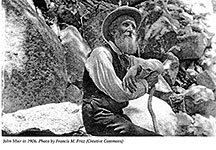
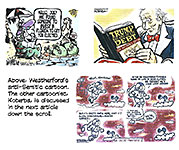
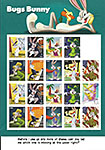
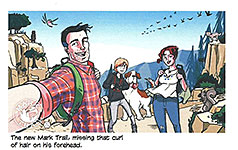
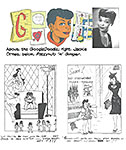
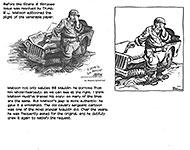

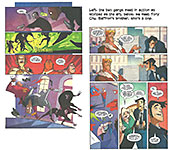


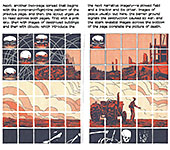
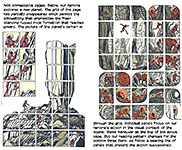
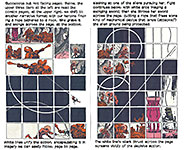
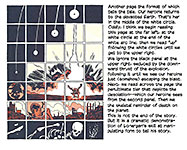
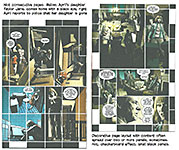

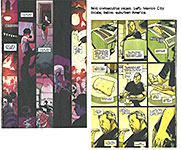
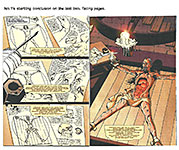

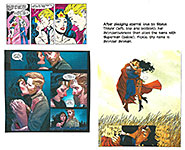
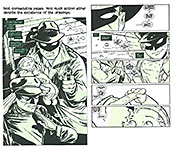
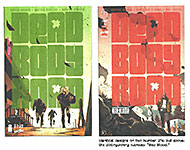
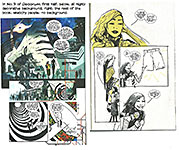
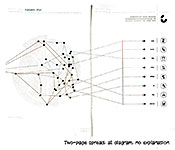
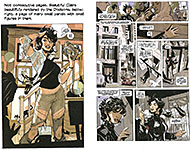
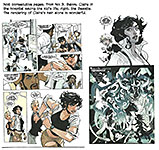

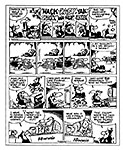
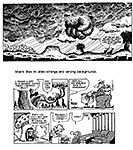
1.jpg)
2.jpg)
3.jpg)
4.jpg)
5.jpg)
6.jpg)
1.jpg)
2.jpg)
3.jpg)
4.jpg)
5.jpg)
6.jpg)
7.jpg)
8.jpg)
9.jpg)
10.jpg)
